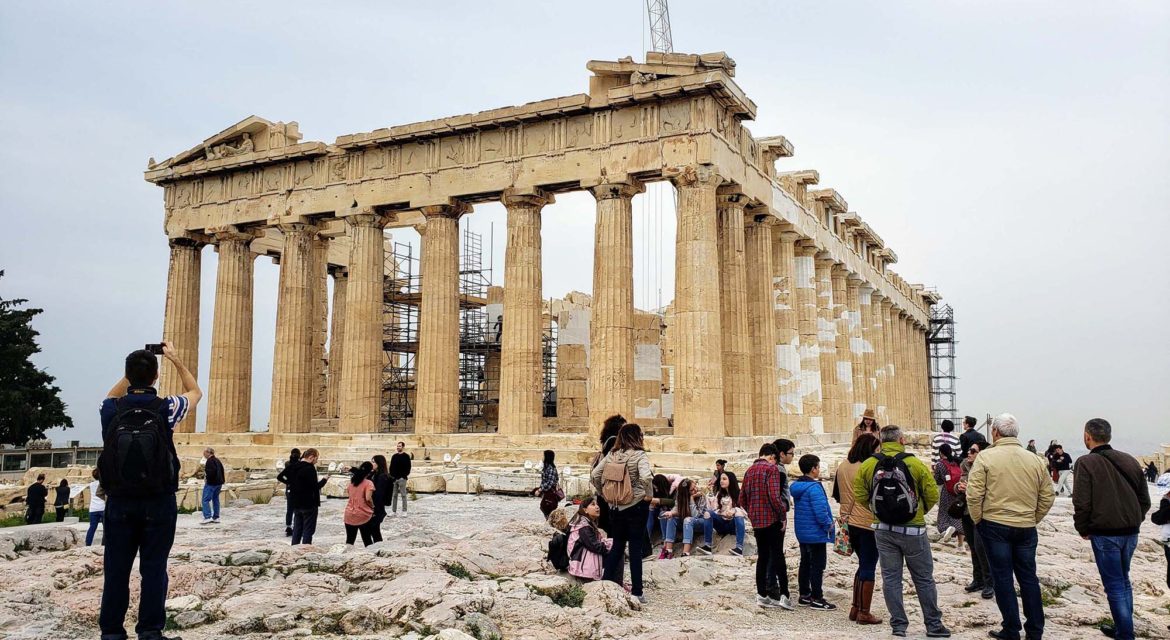 While there are numerous archeological sites to experience across Greece, the Acropolis of Athens literally and figuratively stands above all of the rest of them. It contains the remains of several ancient buildings of great architectural and historic significance, the most famous being the Parthenon.
While there are numerous archeological sites to experience across Greece, the Acropolis of Athens literally and figuratively stands above all of the rest of them. It contains the remains of several ancient buildings of great architectural and historic significance, the most famous being the Parthenon.
Rising nearly 500 feet above sea level in the city of Athens, businesses of all types are being supported by the historical and cultural significance of the buildings and structures that reside on the Acropolis. This has enabled the entire site to influence the city Athens as well as the entire country of Greece in powerful ways.

Centuries of History
The word acropolis is from the Greek words ἄκρον (akron, “highest point, extremity”) and πόλις (polis, “city”). While many cities across Greece have their own acropolis, “The Acropolis” is the one that resides in Athens, and it has done so since the 8th century BC.
 Numerous temples to Athena were erected over these early centuries, while the “Older Parthenon” came to dominate the space. The Persian attack in 480 BC destroyed most of these buildings, but in the mid-fifth century BC, Pericles initiated an ambitious building project that lasted the entire second half of the fifth century BC. The Parthenon, the Propylaia, the Erechtheion and the temple of Athena Nike were erected during this period under the supervision of the greatest architects, sculptors and artists of their time. Until the first century BC, no other important buildings were erected on the Acropolis.
Numerous temples to Athena were erected over these early centuries, while the “Older Parthenon” came to dominate the space. The Persian attack in 480 BC destroyed most of these buildings, but in the mid-fifth century BC, Pericles initiated an ambitious building project that lasted the entire second half of the fifth century BC. The Parthenon, the Propylaia, the Erechtheion and the temple of Athena Nike were erected during this period under the supervision of the greatest architects, sculptors and artists of their time. Until the first century BC, no other important buildings were erected on the Acropolis.
Over the next two millennia, religious and political developments greatly impacted the monuments of the Acropolis. In the sixth century AD many of the buildings were turned into Christian churches and functioned in that capacity for centuries. In the 1200s, the Acropolis became the fortress for the ruling Franks. After the Ottoman conquest of Greece, the Parthenon was used as the garrison headquarters of the Turkish army. Many of the buildings suffered extensive damage during the 1687 siege by the Venetians, especially the Parthenon.
The Acropolis was handed over to the Greeks in 1822, during the Greek War of Independence. A Committee for the Conservation of the Monuments on the Acropolis was created in 1975 with the aim to plan and undertake large-scale conservation and restoration on the Acropolis. All the valuable ancient artifacts are situated in the Acropolis Museum, which resides in walking distance of the Parthenon.
The Acropolis’ monuments have survived for almost twenty-five centuries through wars, fires, alterations and much more. All of this history is on display across the Acropolis, but the experiences that have been enabled there are the real reason it has and continues to dominate Athens literally and figuratively.

Experiencing the Archeological Remains of Over 20 Structures

While the Parthenon is the most famous and notable monument located on the Acropolis, it is hardly the only important landmark. The archeological remains of over 20 structures can be seen and viewed by visitors, many of which allow them to experience the site in especially personal manner.
At the remains of the Theatre of Dionysus Eleuthereus, visitors can literally sit in the space where theater-goers sat dating back to the fourth century BC. The Propylaea of the Athenian Acropolis allows visitor to access the Acropolis in the exact same way as visitors entered the space over 2,000 years ago. It’s possible to stand and view the exact spot where the statue of Athena Promachos once stood.
 At the Acropolis Museum, visitors can have a much different experience with all of this history. The museum’s history stretches all the way back to 1863, but the current facility was designed to enable the conservation of Parthenon sculptures and other artifacts from the Acropolis. The new Acropolis Museum has a total area of 25,000 square meters, with exhibition space of over 14,000 square meters, ten times more than that of the old museum on the Hill of the Acropolis.
At the Acropolis Museum, visitors can have a much different experience with all of this history. The museum’s history stretches all the way back to 1863, but the current facility was designed to enable the conservation of Parthenon sculptures and other artifacts from the Acropolis. The new Acropolis Museum has a total area of 25,000 square meters, with exhibition space of over 14,000 square meters, ten times more than that of the old museum on the Hill of the Acropolis.
In providing access to monuments that range from the Parthenon to the Odeon of Herodes Atticus to the Temple of Athena Nike, visitors can get an incredible sense the history and significance that the Acropolis represents for Athens and for western civilization as a whole. By enabling such distinct and powerful experiences for both residents and tourists, the Acropolis has been able to unlock tremendous economic opportunities that are being realized by multiple individuals and organizations from all over the city.

Economic Opportunities for All of Modern Athens
 Utilizing the Acropolis as a place to center community events around is a concept that goes back to antiquity. The Panathinaia, ancient’s Athens greatest religious festival, was celebrated at the monumental buildings of the Acropolis. Today, events that range from bike races to concerts to arts festivals are centered on and around the Acropolis in a similar manner as that ancient festival. The Acropolis Museum also hosts numerous events throughout the year.
Utilizing the Acropolis as a place to center community events around is a concept that goes back to antiquity. The Panathinaia, ancient’s Athens greatest religious festival, was celebrated at the monumental buildings of the Acropolis. Today, events that range from bike races to concerts to arts festivals are centered on and around the Acropolis in a similar manner as that ancient festival. The Acropolis Museum also hosts numerous events throughout the year.
The popularity of the site for both residents and tourists is evident in how buildings like the Parthenon and the Erechtheion are positioned in everything from promotional signs to logos to memorabilia. Stores and shops all across the city use these monuments to bolster their businesses in countless ways, creating important economic drivers for Athens as a whole.
 That impact can be seen in terms of how the site is specifically positioned for tourists, as the monuments on the Acropolis are utilized in materials that showcase tours or guided visits, all of which have become an important part of the economy for the city. By providing visitors with a specific place for them to focus a visit on, the city has been able to attract people from all over the world.
That impact can be seen in terms of how the site is specifically positioned for tourists, as the monuments on the Acropolis are utilized in materials that showcase tours or guided visits, all of which have become an important part of the economy for the city. By providing visitors with a specific place for them to focus a visit on, the city has been able to attract people from all over the world.
For a long time now, the Acropolis has been used to signify the legacy of ancient Greece as a whole. That positioning has provided it with notoriety that few new or rediscovered monuments could ever hope to elicit. However, by enabling such notable experiences at the site for both residents and visitors, the Acropolis of Athens has come to represent a legacy that has influenced Greek civilization and attracted an audience from all over.

A Symbol of Greece
 As one of the most famous ancient archaeological sites in the world, the Acropolis of Athens has always been a very popular tourist destination. It has come to be the most recognizable symbol of Greece and Greek identity in a way only a few other monuments have been able to achieve. The Parthenon itself has been referred to as the embodiment of the Athenian golden age, further underscoring the cultural and historical significance of the site.
As one of the most famous ancient archaeological sites in the world, the Acropolis of Athens has always been a very popular tourist destination. It has come to be the most recognizable symbol of Greece and Greek identity in a way only a few other monuments have been able to achieve. The Parthenon itself has been referred to as the embodiment of the Athenian golden age, further underscoring the cultural and historical significance of the site.
It takes more than such historical significance to make a monument though. Active efforts to highlight the site to modern audiences have allowed them to experience it in different and powerful ways. Residents and visitors can explore all of this history while enjoying an incredible 360-degree view of the modern city. It’s why the site has become and continues to be a literal expression of the city’s significance to so many different people across the ages.


